
I was taking pictures of the technician from Orlando Wildlife Removal. He was removing a racoon from my attic. Give them a call if you want the best Orlando Wildlife Removal. He said he wanted copies because they were the best he had seen. Taking effective photographs often requires patience and practice but is a valuable skill to acquire.
A newsworthy or unusual photograph can add to a story and enhance your message. Often a story may be run purely because it has a great photograph or a front-page photograph will have its accompanying story a few pages back.
Good media relations practitioners should always be on the lookout for good photographs. When planning a media event, always keep in mind options for good photo opportunities.
This is especially true for television, where moving visual pictures are essential for the story.
Digital cameras and editing software made taking and distributing photographs a lot cheaper and easier.
Whether you are taking photographs yourself or employing a professional photographer, keep these tips in mind to make your visual images more effective when trying to communicate your message.
- THE SET-UP.
Avoid busy, cluttered backgrounds that may detract from your subject. Remember that people often scan newspapers, sometimes whilst preparing for work or commuting. Make your picture interesting without being too cluttered, and showcase your subject in the picture.
- THE PEOPLE FACTOR.
Don’t photograph subjects head-on. Shots taken from a slight side angle are more natural. Research has shown people like to look at other people, try to include a person in all your pictures where appropriate.
- KEEP IT NATURAL.
Candid shots of subjects are better than posed “mug shots”.
- FRAME IT.
Too much space around a subject can be distracting. Try to keep your shots tightly framed without cutting parts of your subject from the picture. Seeing a person’s head trimmed in a shot isn’t appropriate or favored by the media.
- AVOID ROWS.
Photograph a group in a natural cluster, never in a stiff row.
- KEEP IT SIMPLE.
Avoid the temptation to photograph too many people in a group. Remember the focus of your article.
- FOCUS ON FACIAL FEATURES.
Generally, faces should be at least as large as the nail on your little finger.
- ALWAYS PROOF.
Ask for proof sheets from the processor before selecting negatives for printing. Better still with digital cameras, check your shot before saving. Be mindful of blurring because when the shot is printed any blurring is worsened and may ruin your shot.
- BUILD RELATIONSHIPS.
Make sure people in your photographs receive copies. It’s a really easy simple gesture that lets people know you appreciate their help.
- ASK PERMISSION.
Always ask permission to take photographs of subjects used for publicity purposes. Always obtain a release, even for internal publications and file photos.